| Pages:
1
2 |
neptunium
National Hazard
   
Posts: 985
Registered: 12-12-2011
Location: between Uranium and Plutonium
Member Is Offline
|
|
check out this fool!
http://www.ebay.com/itm/Black-Phosphorus-crystal-clusters-0-...
300 bucks for .5 gram ha ha ha ha ha ha!!!!!
what a dicK!
[Edited on 10-12-2012 by neptunium]
|
|
|
kristofvagyok
National Hazard
   
Posts: 659
Registered: 6-4-2012
Location: Europe
Member Is Offline
Mood: No Mood
|
|
Since there is NO commercial supplier for black phosphorous what is not a DIY form of this awesome element so I would say that price could be okay.
Just check the Sigma or the Merck catalog and you will find several more common thing with much higher price that that.
I have a blog where I post my pictures from my work: http://labphoto.tumblr.com/
-Pictures from chemistry, check it out(:
"You can’t become a chemist and expect to live forever." |
|
|
neptunium
National Hazard
   
Posts: 985
Registered: 12-12-2011
Location: between Uranium and Plutonium
Member Is Offline
|
|
no thanks!
getting phosphorus out of phosphates is a fascinating experiment and has been since 1669! i am making my own thank you very much!
the thread on elemental phosphrus on SM is very interesting by the way!
damn greedy bastards!
|
|
|
Boffis
International Hazard
    
Posts: 1836
Registered: 1-5-2011
Member Is Offline
Mood: No Mood
|
|
Back to the subject of this thread:
I checked out various chemistry books on the Forum library to check out the chemistry of PCl3 and PCl5. Interesting...
PCl5 sublimes at 160 C and melts under confinement at 166 C. However, the section goes on to discuss the vapour density of this compound and cites
references that indicate that the vapour is 47% dissociated at 180 C (Textbook of Inorganic Chemistry Vol VI part II). The dissociation being:
PCl5 --> PCl3 + Cl2
It is therefore possible that even at the temperature of say refluxing carbon tetrachloride there will be sufficient dissociation to allow the
reaction with a red phosphorus suspension in this solvent (other solvents such as nitrobenzene and o dichlorobenzene might be possibilities too.
Though they may be more difficult to accomadate in subsequent reactions). If this were to work it would allow a fairly easy means of accessing PCl3;
admittedly as an inseparable solution in CCl4. However, for the preparation of alkyl phosphites I don't think this would be a problem, the mixture of
say triethyl phosphite and carbon tetrachloride should be fairly easy to fractionate (Bp's 156 and 76 C respectively). I'll look into this over the
coming months as it is an intreging possibility.
[Edited on 10-12-2012 by Boffis]
|
|
|
Lambda-Eyde
National Hazard
   
Posts: 857
Registered: 20-11-2008
Location: Norway
Member Is Offline
Mood: Cleaved
|
|
Well, if you take into account Kristof's point and the preparation of this unusual allotrope, the price isn't that ridiculous:
| Quote: |
Amixture of50 g. of distilled, white P and 50g. of Hg is placed
in an ampoule filled with pieces of copper-plated welding rods.
At the same time, 0.5 g. of black P, which has been well pulverized beforehand in an atmosphere of N2, is added as seed
crystals. The ampoule is fused shut and gently heated until the
white P melts. It is then shaken to achieve a good mix. As a result, a layer of seed crystal powder adheres to the newly amalgamated surface of the
welding rod. The ampoule is heated in
a protective iron tube to 220°C and then, over a period of two
days, to 370°C. After a total of eight days, black P forms quantitatively. Its surface sometimes shows traces of white and red
phosphorus.
To produce the seed crystals, a small ampoule filled with
freshly distilled white P and 30-40 at .% Hg is placed in a furnace
preheated to about 370°C. It is left there for three days at this
temperature. It is then heated for one day at 380°C, one day at
390C and three to four days at 410°C. The well-formed spherule s
of black P can be easily separated from the other material.
To extract the crude product from the admixed Hg, the pulverized sample is placed next to a piece of Pb and heated in an
evacuated ampoule for several days at 300-450°C. After repeating
the process with the repulverized sample and fresh Pb, the remaining Hg amounts to about 1 at.%. If gold is used instead of
Pb in the second amalgamation the amount of Hg after heating to
between 370°C and 440°C is reduced to about 0.5 at.%. The Hg
content cannot be further reduced by this or any other method.
|
(From Brauer)
[Edited on 10-12-2012 by Lambda-Eyde]
This just in: 95,5 % of the world population lives outside the USA
You should really listen to ABBAPlease drop by our IRC channel: #sciencemadness @ irc.efnet.org
|
|
|
Hawkguy
Hazard to Others
  
Posts: 326
Registered: 10-10-2014
Location: British Columbia (Canada eh!)
Member Is Offline
Mood: Body is Ready
|
|
There's another method of preparing Phosphorous Trichloride from Calcium Phosphate. Its here (somewhere) http://catbull.com/alamut/Bibliothek/Kings_Chemistry_Surviva... Good luck and please post results! I haven't yet tried, and so I am curious as to
effectivity.
|
|
|
Magpie
lab constructor
    
Posts: 5939
Registered: 1-11-2003
Location: USA
Member Is Offline
Mood: Chemistry: the subtle science.
|
|
A lab report
Introduction
Based on my successful preparation of PCl5 from white P (see Prepublication) I decided to try the same technique in making PCl3.
Solvent Selection
As PCl3 is a liquid I planned to separate the PCl3 from the solvent by distillation. The boiling point of PCl3 is 76°C so I wanted a solvent that
had a significantly higher or lower boiling point. My original selection was pentachloroethane (bp 162°C) as it is a chlorocarbon and therefore I
assumed it would be as good a solvent as CHCl3 (1g/40 ml) or CCl4. But I could not find a source although it could be made from trichloroethylene,
which is available on eBay. I probably could also use heptachloropropane but I also would have to make this (from perchloroethylene).
My next thought was to use dichloromethane (bp 40°C). But I suspected that the chlorination would produce significant CHCl3 (bp 61°C) and CCl4 (bp
77°) as by-products. These would be difficult or next to impossible to separate from PCl3 by distillation.
Then I remembered that I had 500 ml of chlorobenzene (bp 131°C) on hand from a trade with a forum member. Benzene is a good solvent for white P
(1g/35 ml) being, in fact, the best I have seen in the literature excepting CS2. I therefore assumed that chlorobenzene would also be a good solvent.
Availability and fire hazard preclude me from using CS2 although it is by far the best solvent for P.
Chlorination
A 3-neck 500ml RBF with reflux condenser was loaded with 250ml of dried, redistilled chlorobenzene and 5.2g of white P. The pot was heated with a
mantle and magnetically stirred. The P slowly and steadily dissolved until complete dissolution was achieved. Dried Cl2 was then slowly injected
into the hot chlorobenzene. The mantle was then turned off as the heat of reaction kept the pot very hot although not boiling.
Because I had not pre-purged the gas train, condenser, and RBF headspace with an inert gas, considerable P2O5 smoke initially formed. This deposited
on the dome of the RBF. It was white with an orange cast, due to slight tar formation I assume. This was dangerous as it tended to plug the CaCl2
guard tube and I changed out the tube’s cotton plug twice during the initial part of the chlorination when the smoke was being generated.
Fractional Distillation
The RBF was set up for fractional distillation using a 20cm Vigreux column. With the ΔT in bps of 55°C I assumed this would easily give a good
separation. It did not, and the still head temperature went up over 110°C. So I changed to a 20cm Hempel column packed with a ss scrub pad. This
also did not provide a separation no matter how carefully I adjusted the mantle heat. After collecting about 15ml of condensate I quit for the night.
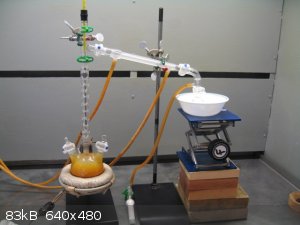
Fractionation with Vigreux column
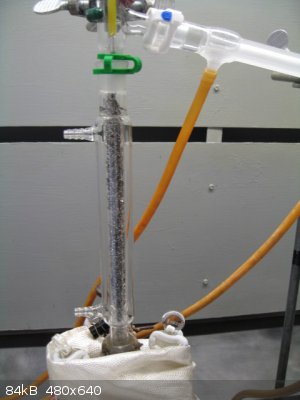
Fractionation with Hempel column
Today I set up the 25mL RBF pot containing the distillate for a second fractional distillation, again using the Hemple column. I placed an aluminum
foil tent on the pot and heated the column up very slowly. When the temperature reached 75°C distillate started coming over. It continued to come
over at 74°-75° steadily (0.5d/s) until there was insufficient heat to bring any more distillate over. So I did manage to capture 6.4g of PCl3.
About 12 ml of liquid remained in the pot, ie, chlorobenzene.
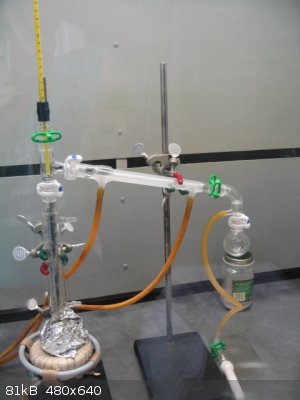
2nd fractionation
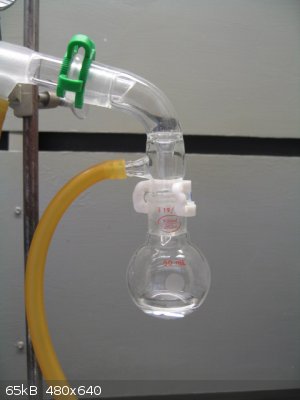
PCl3 distillate
Yield
The yield was 6.4g for a 27.8% yield.
Discussion
The difficulty encountered during the fractionation really has me puzzled. With a 55° degree separation in boiling points this fractionation should
have been easy. I can’t believe it was just poor technique.
Clearly I made a mistake in not first purging the system with an inert gas (I have argon). But this cannot account for the low yield entirely. I’m
wondering if the bulk of the phosphorus is still in the 500ml RBF pot.
Comments, questions, and suggestions are welcomed.
The single most important condition for a successful synthesis is good mixing - Nicodem
|
|
|
Magpie
lab constructor
    
Posts: 5939
Registered: 1-11-2003
Location: USA
Member Is Offline
Mood: Chemistry: the subtle science.
|
|
Yesterday and today I have done some labwork to try to find the missing P from my PCl3 synthesis posted above.
Missing P: (1-0.278)5.2g = 3.75g
Firstly, I weighed the 500 mL RBF before and after cleaning. Assuming the weight differential was P2O5 this accounts for 0.39g of P. This is nearly
twice my estimate of 0.2g. Perhaps more O2 was sucked in through the CaCl2 guard tube as the existing O2 was consumed. Incidentally, the RBF cleaned
up easily using only soap and water.
Secondly, I redistilled the residual 200 ml of chlorobenzene left in the 500 ml pot. I only recovered about 6mL of distillate. To this I added about
10ml of fresh chlorobenzene then redistilled this in a 25ml RBF. I only retrieved a few ml of doubtful quality PCl3 and chose not to add it to my
yield. I did add water to it in a small beaker. At first I saw nothing then noticed about 3 large drops of PCl3 on the bottom of the beaker. I also
noticed that the beaker was getting very hot. Eventually the drops disappeared. The assumed reaction is:
PCl3 + 3H20 ---> H3PO3 + 3HCl
Based on this small scale experiment I have to conclude that this is not a good way to make PCl3. DJF90 has informed me that the German chemistry
forum Lambda-Syn has a high yielding method using PCl5 and red phosphorus.
--------------------------------------------------------------------
Edit:
Other hiding places are possible for the missing P:
(1) unreacted P dissolved in the chlorobenzene, and
(2) dissolved PCl5.
I may do some more investigations.
[Edited on 6-9-2015 by Magpie]
[Edited on 6-9-2015 by Magpie]
The single most important condition for a successful synthesis is good mixing - Nicodem
|
|
|
macckone
International Hazard
    
Posts: 2159
Registered: 1-3-2013
Location: Over a mile high
Member Is Offline
Mood: Electrical
|
|
Chlorobenzene seems a poor choice as it will get chlorinated just like the dichloromethane. There could be polymeric side products with insufficient
chlorine.
|
|
|
Magpie
lab constructor
    
Posts: 5939
Registered: 1-11-2003
Location: USA
Member Is Offline
Mood: Chemistry: the subtle science.
|
|
Quote: Originally posted by macckone  | | Chlorobenzene seems a poor choice as it will get chlorinated just like the dichloromethane. There could be polymeric side products with insufficient
chlorine. |
Isn't a Lewis acid required for chlorination of the benzene ring? However, chlorination of CHCl3 isn't supposed to happen either without radical
formation by UV light but it does to a certain extent. I suppose heat can substitute for the UV.
I wouldn't be surprised to find some dichlorobiphenyl. A small amount of biphenyl is formed when making benzene from benzoic acid.
[Edited on 6-9-2015 by Magpie]
The single most important condition for a successful synthesis is good mixing - Nicodem
|
|
|
Magpie
lab constructor
    
Posts: 5939
Registered: 1-11-2003
Location: USA
Member Is Offline
Mood: Chemistry: the subtle science.
|
|
I am now convinced that most all of the missing P is still dissolved in the chlorobenzene. In my effort to not form PCl5 I simply did not chlorinate
long enough.
The below picture shows an abandoned distillation to recover the chlorobenzene. You can see the P2O5 smoke in the pot as the hot P reacts with the
oxygen in the air.
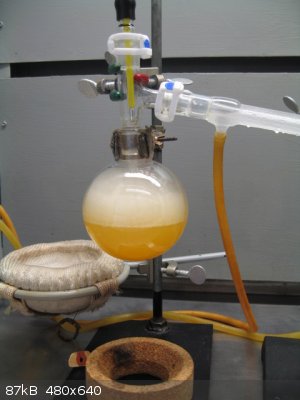
The composition of the yellow colored residue is still unknown. It is not soluble in the chlorobenzene and settles out as a gummy yellow residue. At
first I though it was P4S10, but where would the sulfur come from (thiophene?). I carefully cleaned and redistilled the chlorobenzene before use.
Also, I have never smelled a sulfur smell. When I heated some strongly with a match it did not catch fire but melted slightly and turned partially
black. It is soluble in water and turns the water pH acid.
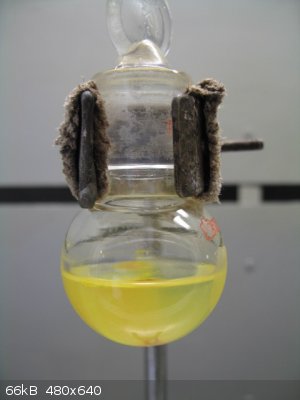
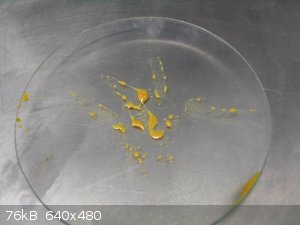
The single most important condition for a successful synthesis is good mixing - Nicodem
|
|
|
Magpie
lab constructor
    
Posts: 5939
Registered: 1-11-2003
Location: USA
Member Is Offline
Mood: Chemistry: the subtle science.
|
|
I gave some thought to continuing the chlorination but decided to just cut my losses. There are reactions taking place that I don't understand.
Also, I'm getting tired of running the hood fan, cleaning glassware, and generating used nitrile gloves. Working with dissolved phosphorus and a
halogenated solvent requires extra caution and maintenance of good hygiene.
The product continues to form the yellow residue. Today I filtered most of it out then set up for distillation to recover the chlorobenzene and try
to burn off the P to P2O5 using a controlled burn, ie, get it hot and expose it to the air. This did occur during the distillation. As the P vapor
came in contact with air at the entrance to the condenser it would form smoke. This in turn would cause a partial vacuum and suck in more air,
repeating on and on. I would have taken a picture but my camera quit as the battery needs recharging.
The distillation is done. The distillate is tainted a fluorescein yellow and there is an orange deposit in the pot.
[Edited on 9-9-2015 by Magpie]
[Edited on 9-9-2015 by Magpie]
The single most important condition for a successful synthesis is good mixing - Nicodem
|
|
|
macckone
International Hazard
    
Posts: 2159
Registered: 1-3-2013
Location: Over a mile high
Member Is Offline
Mood: Electrical
|
|
Chlorination of chlorobenzene happens more readily than benzene.
In an ideal world you would need a catalyst or UV light or heat.
But we don't live in an ideal world. And even a regular light bulb
emits some UV and glass is not totally opaque to UV. Plus you have
some activated chlorine floating around from your primary reaction.
|
|
|
Magpie
lab constructor
    
Posts: 5939
Registered: 1-11-2003
Location: USA
Member Is Offline
Mood: Chemistry: the subtle science.
|
|
Also, I no doubt created some FeCl3 due to the SS316 welding rod immersed in Cl2. But there is much more going on in this product mix.
The pot residue from yesterday's distillation contained most of the remaining P, ~ a gram, mixed with a lot of orange gunk. I burnt most of it off.
I will treat the rest of the waste with 1M CuSO4 using a 1 week soak.
I still think this method could be successful if the right solvent could be found. Chlorobenzene is not the right solvent, however.
The single most important condition for a successful synthesis is good mixing - Nicodem
|
|
|
PHILOU Zrealone
International Hazard
    
Posts: 2893
Registered: 20-5-2002
Location: Brussel
Member Is Offline
Mood: Bis-diazo-dinitro-hydroquinonic
|
|
@Magpie,
Based on the "tiny amount" of reactants, your Hemple column with glass beads must hold quite some PCl3 (by capilarity you may have several grams in
there)...this may account for the apparent low yield.
PH Z (PHILOU Zrealone)
"Physic is all what never works; Chemistry is all what stinks and explodes!"-"Life that deadly disease, sexually transmitted."(W.Allen)
|
|
|
Magpie
lab constructor
    
Posts: 5939
Registered: 1-11-2003
Location: USA
Member Is Offline
Mood: Chemistry: the subtle science.
|
|
I didn't use glass beads but ss scrub pad. But, yes, there was some of the yellow residue on the pad coils.
The 1M CuSO4 reacts fast with the small particles of waste, turning them black immediately. I will let it set a few days then treat this with 5%
NaOCl to destroy the phosphides.
The only waste left will then be ~ 150ml of chlorobenzene*. I see my choices here as 1) incineration, 2) evaporation, or 3) absorb in kitty litter.
I have tried some incineration on a small scale: very nasty with sooty smoke likely containing nasties like HCl and dioxin. I think this choice is
out.
*It is interesting to note that there was a fair amount of solid waste (orange gunk) in the chlorobenzene distillate. The chlorobenzene is therefore
also getting treated with 1M CuSO4.
The single most important condition for a successful synthesis is good mixing - Nicodem
|
|
|
Texium
|
Thread Moved
22-11-2023 at 19:41 |
| Pages:
1
2 |